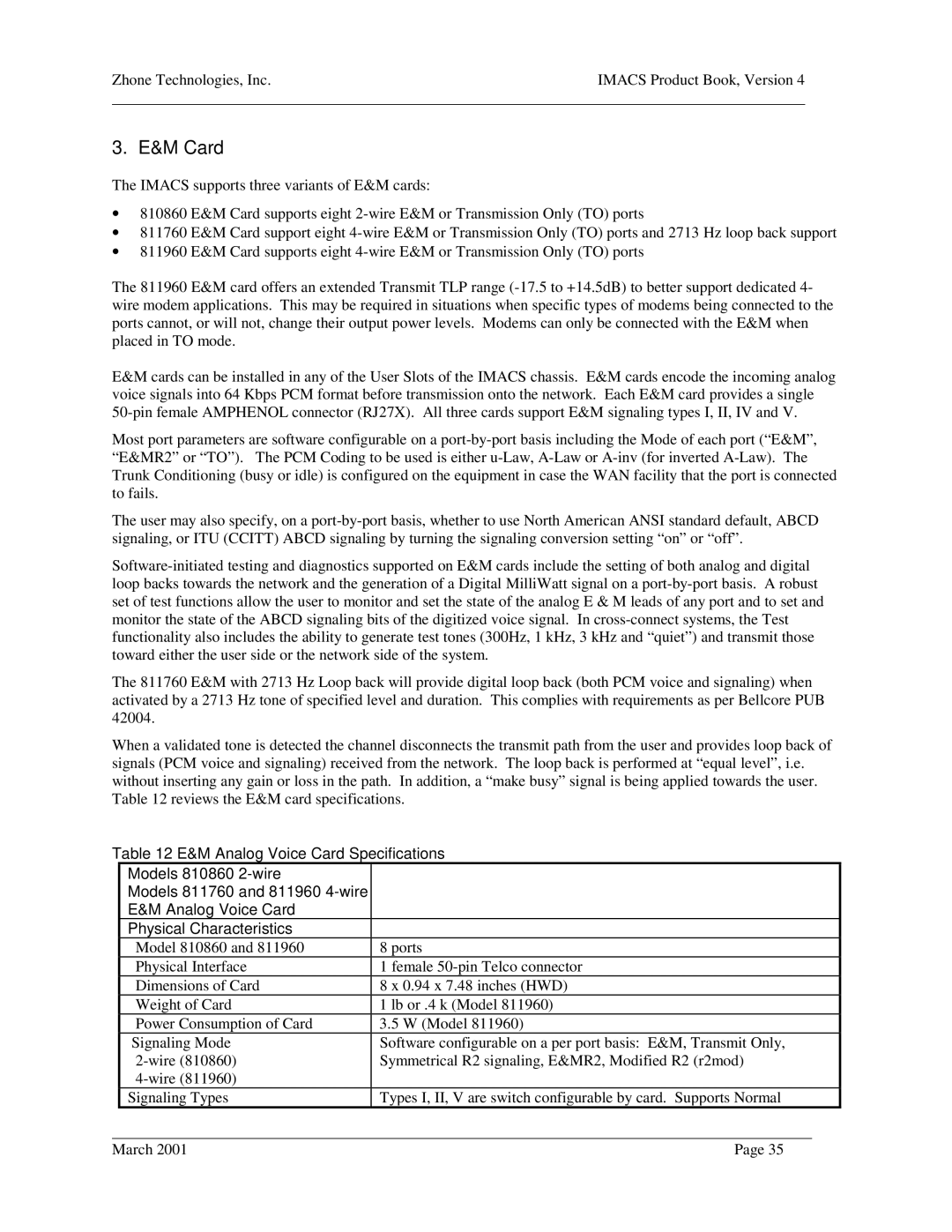Zhone Technologies, Inc. | IMACS Product Book, Version 4 |
| |
3. E&M Card
The IMACS supports three variants of E&M cards:
•810860 E&M Card supports eight 2-wire E&M or Transmission Only (TO) ports
•811760 E&M Card support eight 4-wire E&M or Transmission Only (TO) ports and 2713 Hz loop back support
•811960 E&M Card supports eight 4-wire E&M or Transmission Only (TO) ports
The 811960 E&M card offers an extended Transmit TLP range (-17.5 to +14.5dB) to better support dedicated 4- wire modem applications. This may be required in situations when specific types of modems being connected to the ports cannot, or will not, change their output power levels. Modems can only be connected with the E&M when placed in TO mode.
E&M cards can be installed in any of the User Slots of the IMACS chassis. E&M cards encode the incoming analog voice signals into 64 Kbps PCM format before transmission onto the network. Each E&M card provides a single 50-pin female AMPHENOL connector (RJ27X). All three cards support E&M signaling types I, II, IV and V.
Most port parameters are software configurable on a port-by-port basis including the Mode of each port (“E&M”, “E&MR2” or “TO”). The PCM Coding to be used is either u-Law, A-Law or A-inv (for inverted A-Law). The Trunk Conditioning (busy or idle) is configured on the equipment in case the WAN facility that the port is connected to fails.
The user may also specify, on a port-by-port basis, whether to use North American ANSI standard default, ABCD signaling, or ITU (CCITT) ABCD signaling by turning the signaling conversion setting “on” or “off”.
Software-initiated testing and diagnostics supported on E&M cards include the setting of both analog and digital loop backs towards the network and the generation of a Digital MilliWatt signal on a port-by-port basis. A robust set of test functions allow the user to monitor and set the state of the analog E & M leads of any port and to set and monitor the state of the ABCD signaling bits of the digitized voice signal. In cross-connect systems, the Test functionality also includes the ability to generate test tones (300Hz, 1 kHz, 3 kHz and “quiet”) and transmit those toward either the user side or the network side of the system.
The 811760 E&M with 2713 Hz Loop back will provide digital loop back (both PCM voice and signaling) when activated by a 2713 Hz tone of specified level and duration. This complies with requirements as per Bellcore PUB 42004.
When a validated tone is detected the channel disconnects the transmit path from the user and provides loop back of signals (PCM voice and signaling) received from the network. The loop back is performed at “equal level”, i.e. without inserting any gain or loss in the path. In addition, a “make busy” signal is being applied towards the user. Table 12 reviews the E&M card specifications.
Table 12—E&M Analog Voice Card Specifications
| | Models 810860 2-wire | | |
| | Models 811760 and 811960 4-wire | | |
| | E&M Analog Voice Card | | |
| | Physical Characteristics | | |
| | Model 810860 and 811960 | 8 ports | |
| | Physical Interface | 1 female 50-pin Telco connector | |
| | Dimensions of Card | 8 x 0.94 x 7.48 inches (HWD) | |
| | Weight of Card | 1 lb or .4 k (Model 811960) | |
| | Power Consumption of Card | 3.5 W (Model 811960) | |
| | Signaling Mode | Software configurable on a per port basis: E&M, Transmit Only, | |
| | 2-wire (810860) | Symmetrical R2 signaling, E&MR2, Modified R2 (r2mod) | |
| | 4-wire (811960) | | |
| | Signaling Types | Types I, II, V are switch configurable by card. Supports Normal | |
| | | | |
| March 2001 | Page 35 | |
